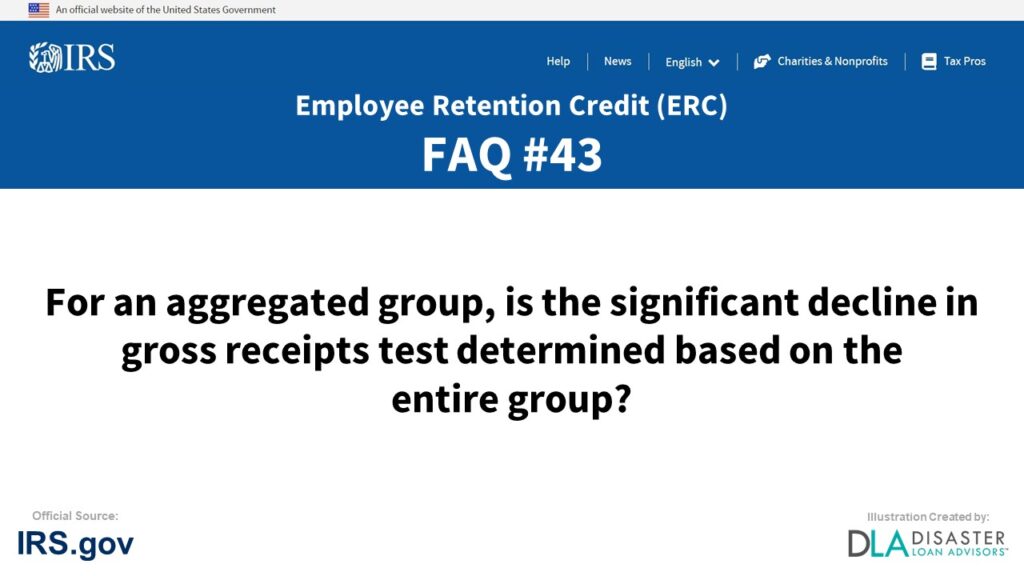
Frequently asked question #43 “For an aggregated group, is the significant decline in gross receipts test determined based on the entire group?” under the Determining When an Employer is Considered to have a Significant Decline in Gross Receipts section of FAQs: Employee Retention Credit under the CARES Act, provided by the IRS.gov to help business owners understand the ERC program. Information is below for the question #43 For an aggregated group, is the significant decline in gross receipts test determined based on the entire group?
ERC Credit Frequently Asked Question #43:
COVID-19-Related Employee Retention Credits:
Determining When an Employer is Considered to have a Significant Decline in Gross Receipts and Maximum Amount of an Eligible Employer’s Employee Retention Credit FAQs
43. For an aggregated group, is the significant decline in gross receipts test determined based on the entire group?
Yes. All entities are considered a single employer for purposes of determining whether the employer had a significant decline in gross receipts if they are aggregated as a controlled group of corporations under section 52(a) of the Internal Revenue Code (the “Code”); are partnerships, trusts or sole proprietorships under common control under section 52(b) of the Code; or are entities that are aggregated under section 414(m) or (o) of the Code.
For more information, see Determining Which Entities are Considered a Single Employer Under the Aggregation Rules.
To be an Eligible Employer on the basis of a significant decline of gross receipts, the employer must take into account the gross receipts of all members of the aggregated group.
If the aggregated group does not experience a significant decline in gross receipts, then no member of the group may claim the Employee Retention Credit on that basis.
Example: Employer J and Employer K are members of a section 52(a) controlled group of corporations. Neither Employer J nor Employer K is subject to a governmental order suspending business operations, and neither received a Paycheck Protection Program loan.
Employer J has gross receipts of $1,000,000 in the second quarter of 2019 and $400,000 in the second quarter of 2020. Employer K has gross receipts of $1,000,000 in second quarter of 2019 and $750,000 in second quarter of 2020.
Although Employer J’s gross receipts in the second quarter of 2020 were 40 percent of its 2019 second quarter gross receipts, neither Employer J nor Employer K can claim the Employee Retention Credit under the gross receipts test.
Employers J and K had combined gross receipts of $2,000,000 in the second quarter of 2019 and $1,150,000 in the second quarter of 2020. Their combined gross receipts for the second quarter of 2020 would have had to be less than $1,000,000 (50 percent of $2,000,000) for Employers J and K to have experienced a significant decline in gross receipts for the second quarter of 2020.
For more Internal Revenue Service (IRS) Department of the Treasury Employee Retention Credit (ERC) Determining When an Employer is Considered to have a Significant Decline in Gross Receipts FAQs, visit the official IRS.gov tax website.
Conclusion and Summary on ERC Credit FAQ #43. For an aggregated group, is the significant decline in gross receipts test determined based on the entire group?
The “For an aggregated group, is the significant decline in gross receipts test determined based on the entire group?” is Frequently Asked Question #43 of many commonly asked questions small business owners are wondering about how to file the Employee Retention Tax Credit (ERTC). The IRS ERC Tax Credit program is a confusing and complex process to determine the correct ERC calculations your business qualifies for. Answers to “For an aggregated group, is the significant decline in gross receipts test determined based on the entire group?” and filling out form 941-X may change slightly from frequently updated rules and regulations from the IRS. Leave a comment below if you have further questions on ERC Credit FAQ #43.
Help Completing / Filing / Claiming the Employee Retention Credit (ERC)
Receive Up to a $26,000 ERC Credit from the IRS Per Employee
Disaster Loan Advisors can assist your business with the complex and confusing Employee Retention Credit (ERC), Form 941-X, and the Employee Retention Tax Credit (ERTC) program.
Depending on eligibility, business owners and companies can receive up to $26,000 per employee based on the number of W2 employees you had on the payroll in 2020 and 2021.
The ERC / ERTC Tax Credit Program is a valuable IRS tax credit you can claim. This is money you have already paid to the IRS in payroll taxes for your W2 employees.
We DO NOT charge a percentage (%) of your ERC Refund like some companies are charging. Some ERC firms out there are charging upwards of 15% to 35% of your ERC refund!
Our professional ERC fee and pricing structure is very reasonable in comparison.
If you are looking for an ERC Company that believes in providing professional ERC Services and value, in exchange for a fair, reasonable, and ethical fee for the amount of work required, Disaster Loan Advisors is a good fit for you.
Schedule Your Free Employee Retention Credit Consultation to see what amount of employee retention tax credit your company qualifies for.
Cover Image Credit: Irs.gov / ERC FAQ / Disaster Loan Advisors.
